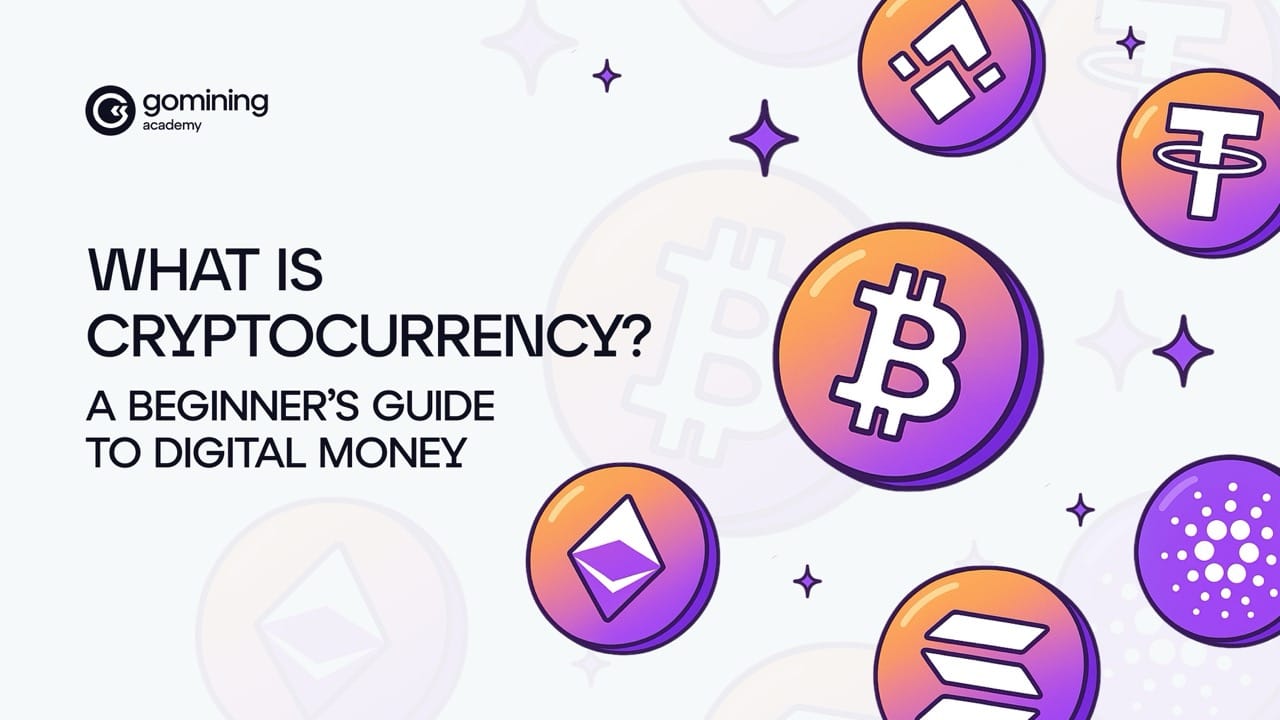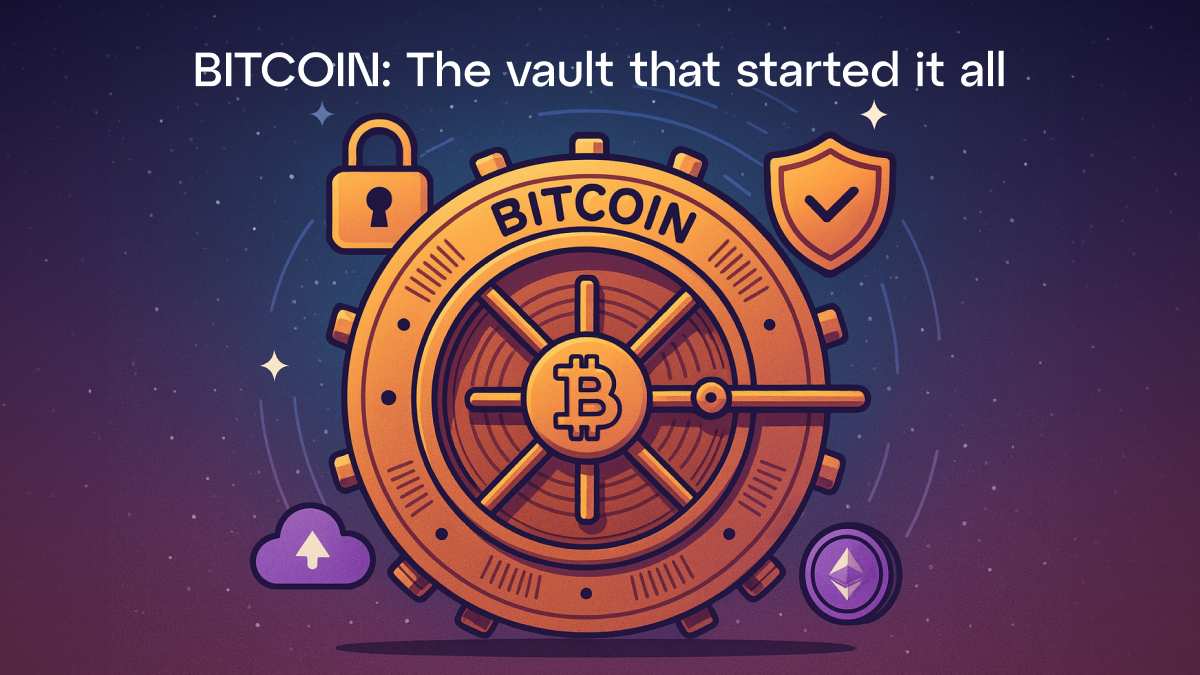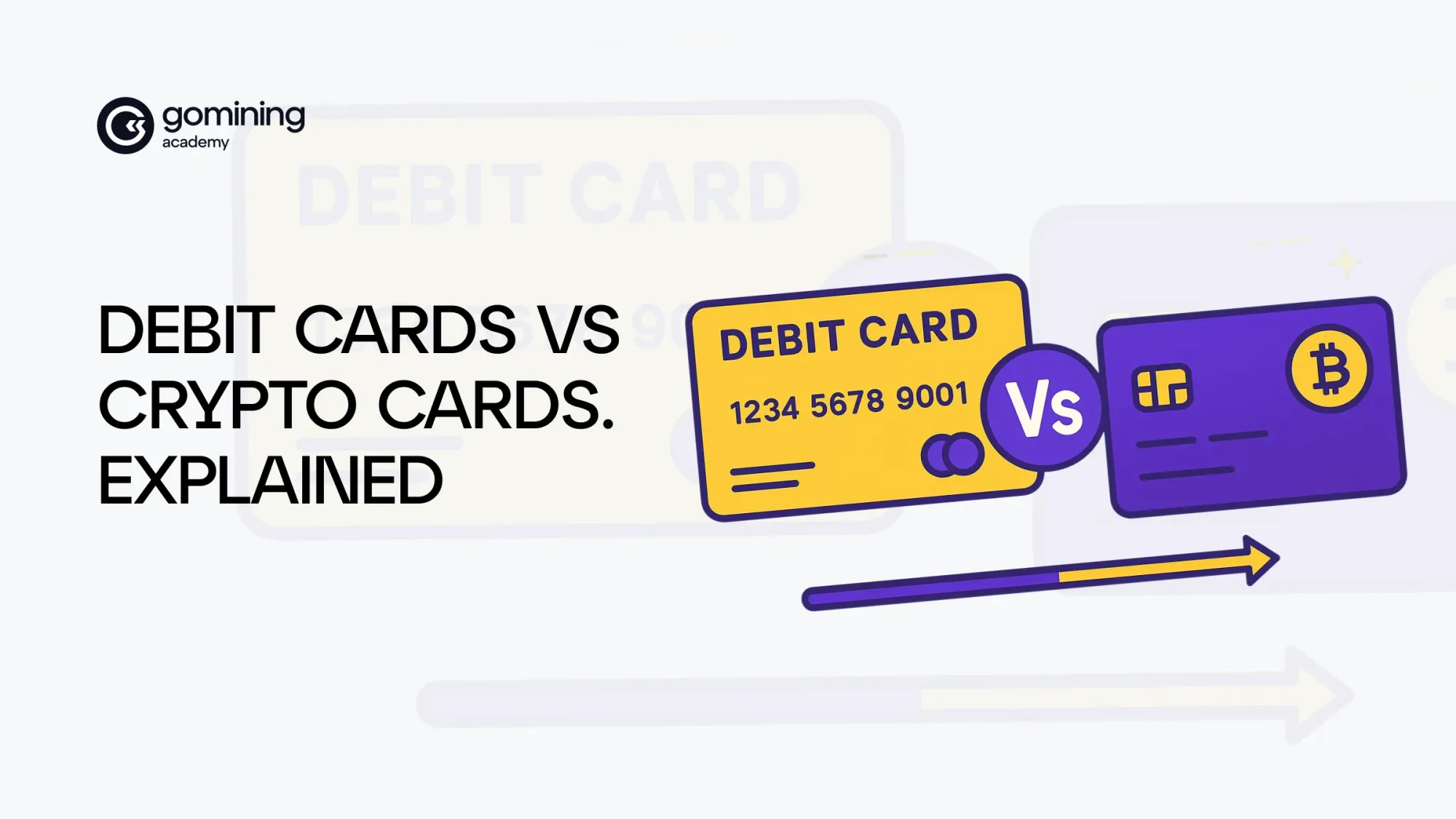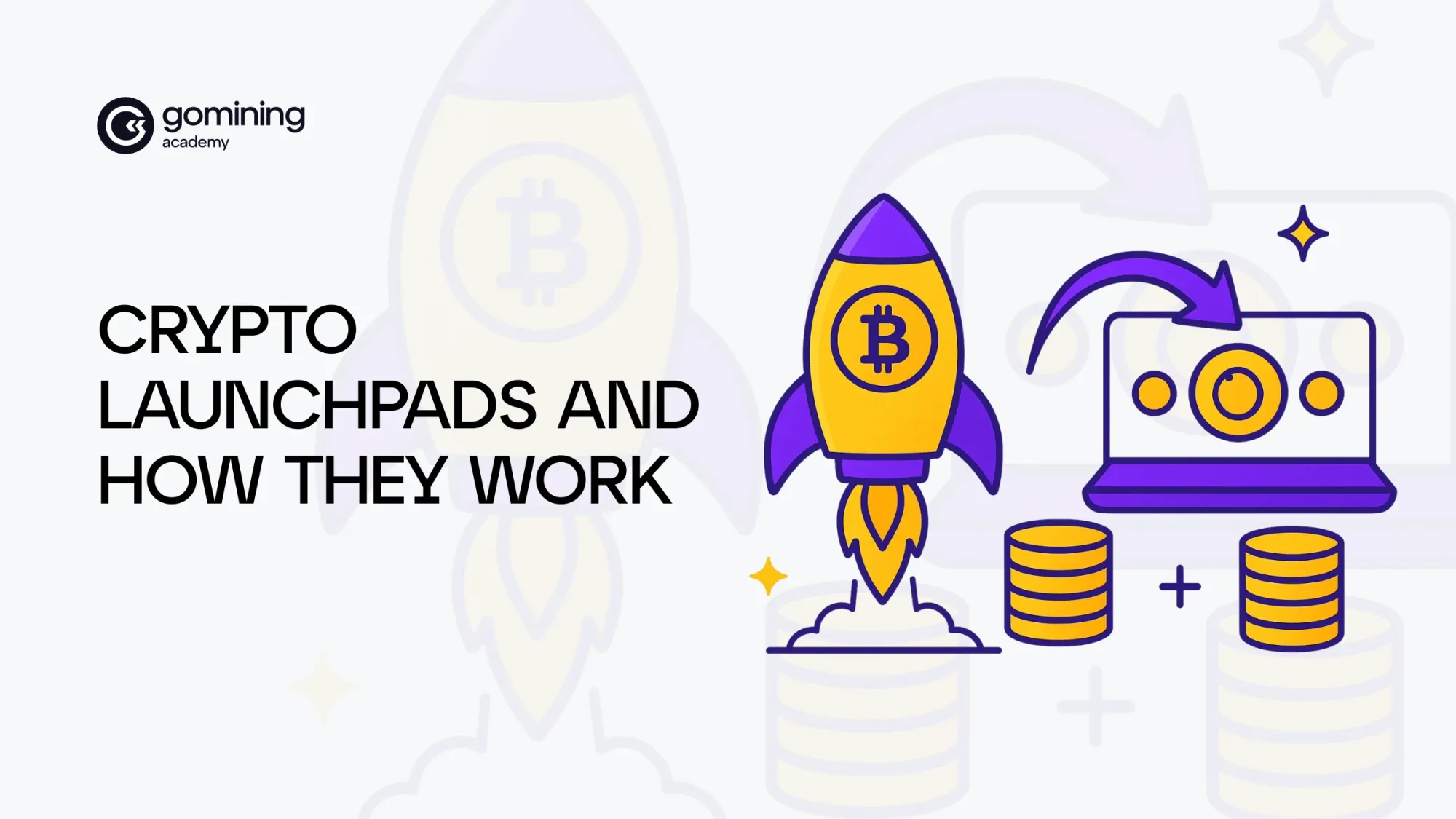What Is Cryptocurrency: A Beginner’s Guide to Cryptocurrencies

Can a currency exist beyond banks and paper bills? Is it possible for money to live purely online, controlled by code rather than governments?
This is cryptocurrency. In plain terms, crypto is digital cash that uses advanced encryption so that transactions are nearly impossible to counterfeit.
It’s completely digital currency secured by cryptography and managed on decentralized networks.
Table of Contents
- Cryptocurrencies 101: How One Crisis Sparked a Financial Revolution
- How Does Cryptocurrency Work?
- Decentralization: The Main Principle of How Does Crypto Work
- Blockchain: The Digital Ledger
- Mining & Staking: How New Coins Are Born
- Proof of Stake (PoS): The Crypto Lottery Lounge
- From Bitcoin to Altcoin: Meet the Stars of the Crypto Galaxy
- Bitcoin: The Vault That Started It All
- Ethereum: The Decentralized Supercomputer
- Altcoins: The Expanding Crypto Universe
- Final Thought: One Coin to Rule Them All? Not Quite
- Investing in Cryptocurrency for Beginners
- How to Buy Cryptocurrencies
- Wallets & Keys: Security Through Code
- Pros and Cons of Buying Cryptocurrency
- Looking Beyond Buying: How GoMining Opens New Crypto Possibilities
- What Is the Future of Cryptocurrency
Cryptocurrencies 101: How One Crisis Sparked a Financial Revolution
To truly understand this groundbreaking digital money, it helps to first look at the circumstances that led to its creation.
Traditional money is issued by governments and managed through banks, which can be slow, lack transparency, and sometimes affected by inflation. After the 2008 financial crisis, a mysterious creator named Satoshi Nakamoto proposed a new kind of money: Bitcoin, the world’s first cryptocurrency, released in 2009.
Bitcoin was the first and most famous example, but thousands of other digital coins and tokens have since appeared. But how exactly does this new form of money function without banks or governments? It all comes down to a few core concepts that power every crypto system.
How Does Cryptocurrency Work?
Now that we've set the stage with crypto's origins, let's dive into the fundamental principles that make it all possible. At its foundation, cryptocurrency depends on a few key principles: decentralization, blockchain technology, cryptography, and digital wallets. Understanding these will make sense of how any crypto system – from Bitcoin to new coins – actually functions.
Decentralization: The Main Principle of How Does Crypto Work
To understand how cryptocurrencies work, think back to early 2000s file sharing apps like Napster or BitTorrent. Instead of downloading a song from a single server (like iTunes), you pulled pieces of it from dozens of users all around the world. No central authority controlled the network — it was peer-to-peer.
A peer is just someone who’s at the same level as you –in school, your classmates are your peers. In tech, a peer is another computer or user on the same network. So, “peer-to-peer” (often written as P2P) simply means from one person (or computer) directly to another — no middleman, no boss, no central authority.
That’s exactly how crypto networks function. Cryptocurrencies like Bitcoin and Ethereum use peer-to-peer networks to transfer value directly between users, without needing a central server or bank to oversee the process. Each participant runs a small piece of the network, and together they maintain a global, unstoppable system that operates 24/7 — no middleman, no off-switch.
This peer-to-peer design means anyone can join the network, verify transactions, and use the currency.
Unlike national currencies (dollars, euros, etc.), most cryptocurrencies are decentralized. This means no single entity (like a government or bank) controls them. Instead, the network is maintained by many computers (called nodes) around the world.
These nodes run open-source software and follow agreed rules. Because no central server exists, cryptocurrencies keep working 24/7, and no one company can shut them down. Cryptocurrency allows a person to freely make payments and transfer their crypto assets without needy middlemen like banks and payment processors
Blockchain: The Digital Ledger
At the heart of every cryptocurrency is a blockchain. The blockchain is the technology that securely records all crypto transactions in a transparent, tamper-proof way. Think of it as a digital ledger — a record of all transactions ever made on the network.
Imagine a massive shared Google Sheet — but instead of your co-workers accidentally deleting rows, this one automatically locks every edit forever. You can see who sent what, when, and to whom, but nobody — not even the person who made the change — can alter the history.
In practice, when you send crypto to someone, your transaction is added to a new block. That block is then broadcasted and others can check if it is legit on the network before it’s permanently added to the chain. Once confirmed, that record is practically unchangeable.
This tamper-proof chain ensures everyone sees the same version of history — no edits, no overlords. Everyone sees the same transparent history, and once something’s written on the blockchain, it’s permanent.
🛠️ Mining & Staking: How New Coins Are Born
So… where do cryptocurrencies actually come from? Do they just appear out of thin code?
Not quite. New coins are created and transactions are verified through a system called a consensus mechanism — basically, a way for everyone on the network to agree on what’s true. There are two main methods you’ll hear about: Proof of Work (PoW) and Proof of Stake (PoS).
⛏️ Proof of Work (PoW): The Digital Puzzle Race
This is how Bitcoin works. Imagine a global race where thousands of high-powered computers are all trying to solve a ridiculously hard math puzzle. The first one to crack it gets to add the next page to the blockchain (the ledger of all transactions), and as a reward, they’re handed some brand-new shiny bitcoin.
This process is called mining, and the people running those machines are called miners.
To keep things fair (and secure), the puzzle is intentionally difficult and energy-hungry. It’s like asking every miner to play Sudoku… but with a billion possible combinations and a stopwatch running.
Why all the effort? Because once a block is added, it becomes extremely hard to change, and that’s what protects Bitcoin’s history from being faked or tampered with.
🔋 Downside? It burns a lot of electricity. Bitcoin’s security comes with an energy price tag.
🌱 Proof of Stake (PoS): The Crypto Lottery Lounge
Newer blockchains — including Ethereum after its big upgrade — use a greener method called Proof of Stake. Instead of racing to solve puzzles, participants lock up (or "stake") some of their crypto like a security deposit. The network then randomly picks someone from the stakers to add the next block and earn rewards. The more coins you stake, the better your chances — kind of like buying more tickets in a raffle.
Staking is much less power-hungry because it doesn’t require all that constant number-crunching. It's more like a well-behaved lottery where everyone agrees to play fair… or lose their stake.
🛡️ And don’t worry — if you’re not ready to stake coins or run a validator node, you can still buy the coins on an exchange. Most beginners don’t need to worry about mining or staking — unless you’re curious and want to get your hands dirty (or start earning passive income with staked assets).
From Bitcoin to Altcoin: Meet the Stars of the Crypto Galaxy
With an understanding of the underlying technology that powers digital currency, you're now ready to meet the actual currencies that utilize these principles. Welcome to the wild, wonderful world of cryptocurrency — where digital coins don’t just act like money, they build whole new worlds. Let’s break down the biggest names on the blockchain, starting with the one that started it all...
Bitcoin: The Vault That Started It All
What is Bitcoin? Bitcoin (BTC) is the first and most iconic cryptocurrency. Created in 2009, it was designed as decentralized, peer-to-peer digital cash — money that lives on the internet, without needing banks, governments, or permission.

People often call Bitcoin “digital gold”, and for good reason:
- Its supply is fixed at 21 million coins — no more, ever.
- It uses proof-of-work mining, making it secure but energy-hungry.
- It’s fully decentralized — no CEO, no central company, no kill switch.
Bitcoin isn’t trying to replace the internet. It’s not chasing app dreams. It just wants to store and move value, clean and simple. Think of it as the digital version of locking your wealth in a bulletproof vault.
🔐 Bitcoin is slow but secure. Heavy, but honest. It’s money for people who don’t want their money messed with.
Ethereum: The Decentralized Supercomputer
Then came Ethereum (ETH) — and it flipped the script.

If Bitcoin wanted to kick banks out of the system, Ethereum asked: "Why stop there?"
Ethereum’s mission isn’t just to move money — it’s to rebuild the web itself, but without middlemen. Instead of Facebook, Google, and Amazon, Ethereum envisions apps and services that run on code, not corporations.
At the heart of Ethereum are smart contracts — little programs that live on the blockchain and execute automatically when conditions are met. Stack a few of them together and you get dApps (decentralized apps). They look and feel like normal apps… but without a CEO, a kill switch, or a board of bored billionaires.
🧰 If Bitcoin is the vault, Ethereum is the toolbox — programmable, powerful, and wide open for builders.
🔄 Altcoins: The Expanding Crypto Universe

Any coin that isn’t Bitcoin? It’s called an altcoin — short for “alternative coin.” Some mimic Bitcoin with tweaks, others race to beat Ethereum at its own game, and many carve out totally new niches.
Let’s meet a few major players:
🔹 Platform Coins: The Ethereum Rivals
These altcoins focus on building faster, more scalable blockchain platforms for dApps and smart contracts.
- Solana (SOL): Fast, cheap, and sleek — but prone to hiccups and occasional outages. Think of it as a high-speed train that sometimes needs rebooting.
- Cardano (ADA): Known for its careful, peer-reviewed approach. More professor than cowboy.
- Avalanche (AVAX): Designed for speed and scale, with a multi-chain twist. Think of it as a blockchain metropolis with many neighborhoods.
🌌 Final Thought: One Coin to Rule Them All? Not Quite
No single cryptocurrency does it all — and that’s kind of the point.
- Bitcoin wants to be money.
- Ethereum wants to be infrastructure.
- Altcoins want to fill every gap in between — speed, privacy, scalability, usability.
Together, they create a growing digital ecosystem where money, software, and community collide — and you get to choose how deep you dive.
Investing in Cryptocurrency for Beginners
Now that you've met the major players and understand the diverse landscape of cryptocurrencies, you might be ready to take the next step: acquiring some digital money. Let's walk through the initial steps of buying, storing, and eventually using cryptocurrency.
The good news is you don’t need to understand every detail to get started. You’ll basically need to buy some crypto, store it safely, and use it. Here’s a step-by-step overview.
🪙 How to Buy Cryptocurrencies
If you’ve ever wondered “How do you buy cryptocurrency?”, the good news is that buying cryptocurrency is simpler than it sounds. Below is a quick, step-by-step look at how to buy cryptocurrencies safely for the first time.
Your first step is to pick a cryptocurrency exchange — a website or app where you can trade your regular money (also called fiat, like dollars or euros) for digital coins.
Popular options include Coinbase, Binance, and Kraken.
✅ Look for platforms that are:
- Reputable and well-reviewed
- Easy for beginners to use
- Offering the cryptocurrencies you want (like Bitcoin or Ethereum)
- Charging fair fees
- Equipped with strong security features
2. Create and Fund Your Account
Once you've picked an exchange, you’ll need to:
- Sign up
- Verify your identity (to comply with regulations)
- Link a payment method (like your bank account or debit card)
3. Place Your First Buy Order
Once your account is funded, it’s time to buy your first crypto!
- Choose the coin you want (e.g. Bitcoin, Ethereum)
- Enter how much money you want to spend
- Hit Buy
- Confirm your order
On beginner-friendly platforms, it’s often as easy as shopping online — just click, confirm, and done.
4. Start Small and Stay Secure
Crypto prices go up and down all the time, so it’s smart to start with a small amount until you get comfortable.
Also:
- Enable two-factor authentication (2FA) for extra account protection
- Avoid sharing login info or clicking sketchy links
- Stick to well-known exchanges that follow proper security and legal protocols
🎯 Quick Tip:
Don't worry about buying a “whole” Bitcoin — most cryptocurrencies are divisible, so you can buy as little as a few dollars' worth. Every satoshi (tiny unit of Bitcoin) counts.
👛Wallets & Keys: Security Through Code
So once you have your crypto, where do you keep it? Since crypto is digital, you can’t stash it in a safe or under your mattress. What you will need is a cryptowallet Cryptocurrencies live on the blockchain — kind of like entries in a giant digital notebook that everyone can see. When you “own” crypto, you don’t actually hold a coin in your hand. What you really have is a secret password (called a private key) that proves some of those coins on the blockchain belong to you — and only you can move or spend them.
Cryptocurrencies use private keys as digital signatures to keep things safe and authentic. Here’s how it works:
- Your public key is like your email address — you can share it with others so they know where to send money.
- Your private key is like your password but it is more like your digital signature — it must be kept secret. It’s what proves that it’s you and you own your crypto and can manage it. If somebody else gets it, they can impersonate you.
When you send crypto, your wallet uses your private key to sign the transaction — sort of like a unique digital fingerprint. Other computers on the network use your public key to verify that the signature is real, without ever needing to see your private key.
This system ensures that only you can spend your coins, and no one can fake a transaction or copy your crypto. It’s what makes cryptocurrency secure without needing a central authority like a bank.
A wallet can be software (an app on your phone or computer) or hardware (a special USB device). Its job is to generate and store your private keys and interact with the blockchain. You could also leave it on the exchange, but that means trusting a third party — which comes with its own risks. If something bad happens to the exchange you could lose all your crypto.
💰 Pros and Cons of Buying Cryptocurrency
Armed with the knowledge of how to buy and safely store your digital assets, it’s time to weigh the bigger picture and decide whether to invest in cryptocurrency. Let’s look at the key pros and cons of cryptocurrency.

Looking Beyond Buying: How GoMining Opens New Crypto Possibilities
If you’re exploring ways to make your crypto journey more rewarding—or just want more options than simply buying and holding—GoMining offers an entire ecosystem built for modern digital asset users. And I am sure you might be wondering : Is Bitcoin mining still profitable in 2025? It depends on how you do it. GoMining brings crypto mining online, giving you all the benefits of a massive mining rig without the having to invest so much. What is a Bitcoin mining app? It is a way to mine Bitcoin as a pro online, without having to commit to millions of dollars.
With GoMining’s digital miners, you can own NFT-backed mining power that generates Bitcoin daily, without setting up your own hardware. You can browse their latest digital miner collection and innovative GoMining digital avatars, and use these assets to tailor your strategy. All this is easy to manage through GoMining’s crypto mining app, where you can track your rewards, upgrade your status though the GoMining VIP rewards program for extra perks.
Learn how the platform’s own crypto tokenomics work along with their own secure token in giving users voter rights, paying for the maintenance fees of your digital rig and other perks. For those who love a little friendly competition, join their mining game and battle for even more mining rewards.
Bitcoin’s future looks more prosperous, as it is gaining worldwide adoption. Already there is a strategic Bitcoin reserve and more people are using it as a way to store their wealth. Is Your Bitcoin Mining App a Smarter Way to Mine BTC? The best place to start is by going to GoMining’s crypto mining calculator to estimate your possible earnings. And if you want to go pro, you can even compare top hashpower providers before making your move so you can see your return on investment.
Whether you’re new or looking to level up your crypto strategy, GoMining gives you all the tools and insights to get more from your digital assets—no advanced technical skills required.
What Is the Future of Cryptocurrency
We’ve covered a lot in this beginner’s guide—from understanding what is crypto, to how it works, to the basics of how to invest in digital currencies and simple tips on how to buy crypto safely. Along the way, you’ve learned about different types of digital currencies, the pros and cons of getting involved, and what to watch out for as you start your crypto journey.
Why people buy crypto? There are many reasons for this.
Analysts debate the future of the cryptocurrency industry, but most agree clearer regulations are on the way. As governments and big companies bring in clearer rules and stronger security, cryptocurrencies will likely become even more user-friendly. Buying, saving, or spending digital assets could soon feel just as normal as any online banking. future of the cryptocurrency. The future of cryptocurrency looks promising indeed.
If you’re thinking about making your first cryptocurrency investment or are still figuring out how to buy crypto, the process is getting easier all the time. Just remember to take things slow, start with small amounts, and only use money you’re comfortable risking. Stick with well-known coins, protect your accounts, and keep learning as you go.
The story of cryptocurrencies is still unfolding, but if you stay curious and cautious, you’ll be ready to make the most of whatever comes next in this exciting world.


